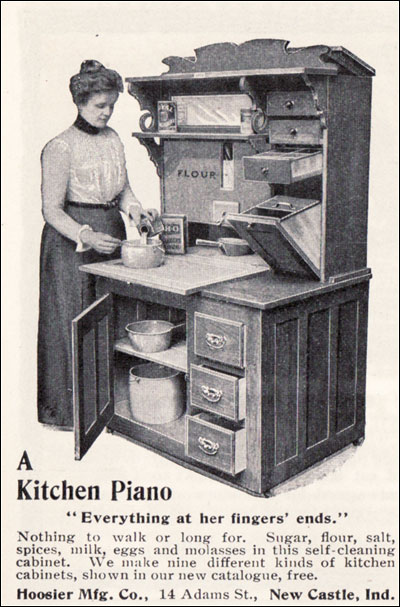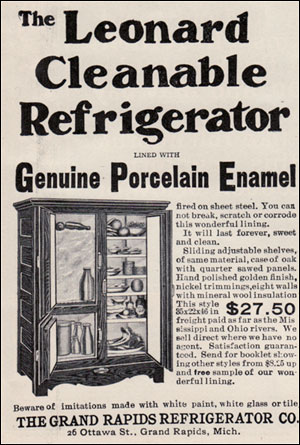Coming soon
- Design of early kitchens
- Hoosier-style cabinets
- Refrigerators & iceboxes
- Flooring
- Kitchen work surfaces
- Ranges & stoves
Bibliography
Early 20th Century American Kitchens
Kitchen Interiors — 1900 to 1919
 One
of the first things that strikes you about American kitchens from 1900
through the 'teens is how simple they were.
One
of the first things that strikes you about American kitchens from 1900
through the 'teens is how simple they were.
The kitchen was a workroom and often relatively small even in large homes. There was typically a sink with a counter or drainboard on either side, a woodburning or gas range, and table. Some cabinetry might have been built in, but not always. Shelving was often open and free-standing cupboards were common.
The second essential component of the kitchen was a pantry that was integrated more or less into the kitchen. Depending on the configuration, it may have been a butler's pantry where dinnerware and dishes were washed and stored. Typically a small room between the kitchen and the dining room, the butler's pantry served as a buffer between the smells and heat of the kitchen and the calm civility of the dining room.
A more familiar function of the pantry was its use as a convenient store room for staples, canned goods, cleaning equipment, and cooking equipment not used on a daily basis. Occasionally, homes had both a utility pantry and a butler's pantry as seen in Radford's 1908 Design 7011.
If the quantity of published kitchen images is any indication, little consideration was given to organizing this space beyond what was deemed necessary for healthy food production. Housewives were advised to keep it simple and clean. Often, the kitchen was the domain of a day servant or maid in many middle-class households.
The early beginnings of the modern kitchen
In the late 1890s the kitchen began its change into the well-appointed room we know today. With the Industrial Revolution came new concepts in efficiency. Scientific discoveries of microscopic life, like bacteria known to cause disease, became the fodder of many an article in various publications exhorting homemakers to adhere to the highest standards of cleanliness. Though we don't give them a thought today, terrible diseases like typhoid and cholera were scourges that were well known then. (House Beautiful ran a regular series on household science and covered the basics of chemistry and bacteriology.)
One innovation was the "Kitchen Piano." In kitchens that had virtually no conveniences but running water (which at the time would have been considered miraculous by grandmothers), a kitchen cabinet that provided "everything at her fingers' ends" would have found a ready audience in American homemakers. One of the first companies to advertise this remarkable kitchen center was the Hoosier Manufacturing Company of New Castle, Indiana. The image (top right) shows one of the earliest ads as it was published in Ladies Home Journal in 1901. Over the next three decades, Hoosier would continue to refine its design and attract such competitors as McDougall and Sellers.
Keeping it cool
It was well understood that keeping food cool prolonged its life and prevented food poisoning. Refrigeration as we know it today was unknown, however, in 1900.

Iceboxes were the common solution and came in a wide ranges of sizes and materials. The preferred box was usually made of oak and the better ones were lined with enameled metal. Zinc-lined boxes were common but less desirable because they tended to pit and retain smells.
While it was possible to have a Brunswick Ice Making Plant by 1911, such a mechanical expense was well beyond the means of the average homeowner. They had to soldier on with their ice box. The Leonard Cleanable Refrigerator (left) was typical of the more common type. This ad appeared in House Beautiful in 1905. (Leonard later became Kelvinator, one of the larger refrigerator companies through the 1920s.)
The ice box was generally located on a back porch or hallway with a door to the outdoors to provide the iceman and milkman easy access.
Cleanliness in the kitchen
It's during the first years of the 20th century that hard surfaces for the kitchen are discussed. Ease of cleaning is essential. Enameled surfaces, durable oil-based paints, and easy to clean flooring like linoleum became popular with many housewives.
In the future
As we collect more information and organize it, we'll publish more about kitchens from 1900 to 1920. We have material to show kitchens, layouts, materials, and color schemes (buff-yellow was a favorite because it reflected the light well and made blue and white dishes look nice ... our great-grandmothers really weren't much different from us). We'll include articles on the changes in refrigeration, cooking including the variety of stoves, changes in washing machines, and other innovations like the central vacuum cleaner.
Additional reading
For an intriguing look into the lives of domestic servants, read "Experiences of a Hired Girl" at the History Matters site by George Mason University.
Old House Living has a nice overview on early 20th Century kitchens with a few very illustrative photos.
© 2008–2016 — Antique Home Style
Books, ETC.
